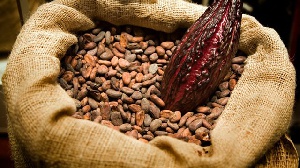Cocoa prices are currently pluming multi year lows, with New York prices below $2,000 a tonne, a level they have only fallen below for one brief period in the last eight-and-a-half years.
Pressure on prices is coming from resurgent West African production, at a time of supressed demand.
But analyst Judith Ganes-Chase warned that the current picture of glutted markets could change rapidly next season, if weather changes.
Weather 'a concern'
Ms Ganes-Chase said there was a possibility that "the weather may become a concern again with the possibility of El Nino making a resurgence later in the year".
Ms Ganes-Chase noted "potential for changing weather after a period of a weak La Nina and now may move back towards El Nino which poses possible production risks later in the year that could impact 2017-18 output".
El Nino is associated with drier weather in West Africa, and would make production prospects for 2017-18 "far less certain," Ms Ganes-Chase said.
This weather uncertainty would come at a time that "producers will be facing their own challenges from lowered prices".
"As much as the market is focused on a period of surplus for this season, this may not last," she warned.
Slow arrival
For the current season, Ms Ganes-Chase noted that despite the size of the crop in West Africa, arrivals at ports have been slow.
"Ivory Coast arrivals are only on par with year ago levels rather than a hefty increase to reflect the bigger crop being harvested," Ms Ganes-Chase said.
Part of this is down to defaulting by local exporters, who failed to properly hedge their purchases.
As international prices tumbled, local exporters found themselves unable to pay the state-mandated farm gate prices to farmers.
Contact cancellation
But this is pressuring prices, due to ideas that the defaults have left a large amount of unsold cocoa in the market.
"Estimates on the size of possible defaults from local exporters has mushroomed casting a dark cloud over the cocoa market," said Ms Ganes-Chase, with some ideas going as high as 300,000 tonnes.
"The cocoa board is reselling 200,000 tonnes and expects the local exporter to pay for the losses rather than the funds deducted out of the treasury of the cocoa authority," Ms Ganes-Chase said.
"If indeed the defaults are as large, then this would explain why arrivals are not showing a large gain year over year for the Ivory Coast," Ms Ganes-Chase said.
But as she pointed out, this does not explain why cocoa arrivals for Ghana are also smaller than expected, a fact that she called "puzzling".
Business News of Monday, 13 February 2017
Source: Agrimoney
Cocoa market glut may not last - Analyst warns
Entertainment
















